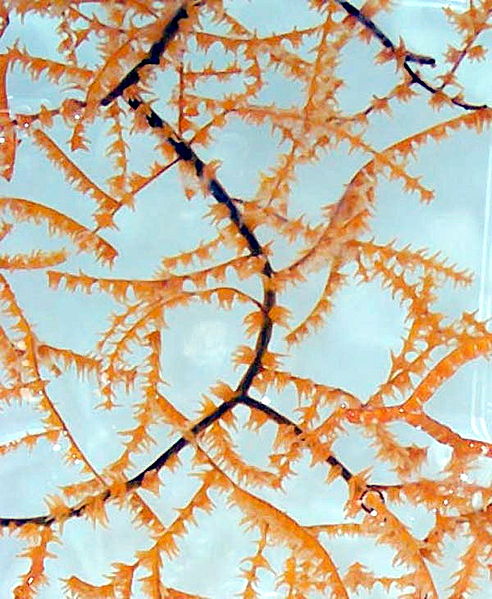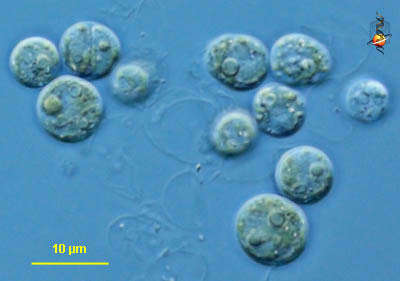 Away down deep in Hawaii, far from the reach of light you or I could see, lie spiny black corals. By deep, I’m talking deep — on the business end of 1000 feet. For a long time, no one thought these corals could host symbiotic algae, as most corals do, because there is so little light at those depths.
Away down deep in Hawaii, far from the reach of light you or I could see, lie spiny black corals. By deep, I’m talking deep — on the business end of 1000 feet. For a long time, no one thought these corals could host symbiotic algae, as most corals do, because there is so little light at those depths.
Yet that is precisely what scientists have found. In 71 percent of the black coral species examined at up to 1,300 feet beneath the surface, scientists found symbiotic algae either identical to or nearly identical to that found in surface corals. That’s amazing! What the heck are they doing there? Is the tiny amount of light that makes it enough to sustain them? Or do they retain their photosynthetic apparatus in spite of not using it? Do the corals simply keep algae because there’s no great cost to *not* doing so, and it’s already programmed into their genes?
Black corals, like all coral, are actually cnidarians like jellyfish, anemones, and sea pens. In essence, they are animals that have taken up underwater lichenization: primary colonizers that slowly build up the infrastructure (lichens: soil, coral: calcium carbonate high-rises and sand) that will support other life. But instead of fungi trapping eukaryotic (nucleated) green algae or cyanobacteria (as in lichens), we have colonial cnidarians trapping dinoflagellates called zooxanthellae. Each little coral individual, or polyp, is like an upside down, anchored jellyfish (complete with little particle-trapping, retractable tentacles) with photosynthetic dinoflagellate tenants inside. Black coral polyps aren’t black, but their skeletons are. Black corals also have tiny spines on their skeletons, lending them the name “spiny thorn coral”.
Let’s have a closer look at the renters:

Symbiodinium -- the dinoflagellate zooxanthellae of black corals too. Creative Commons David Patterson and Mark Farmer. Non-Commercial Use Only.
Look carefully: you will see little brown spots, which are the symbionts inside the symbionts; that is, their own endosymbiotic chloroplasts, which were once photosynthetic bacteria. At some point long ago, they themselves were sucked in by an ancestral dinoflagellate and co-opted for its own personal use.
Corals aren’t the only ones that keep dinoflagellate food replicators right inside them (“Cellulose. Earl Grey. Hot.”): Other organisms that can host zooxanthellae — several of which, unless you’re a biologist, you’ve probably never heard of — include jellyfish, clams, foraminifera, sea slugs, ciliates, and radiolaria. Depending on how you look at it, these algae are either getting free stays and all-you-can-make buffets left and right in the ocean, or they are getting bullied by half the kids in school. The relationship between the dinoflagellate and its coral hosts, in particular, seems ambiguous as best right now; while some scientists argue they benefit from the association, others say the coral is holding them captive and forcing them to do its bidding (in support, they point out that the algae can reproduce perfectly fine — and many times faster — on their own. The same is not true for the coral). The same arguments have been made for the lichen association, and I think the jury is still out on that one too.
Not all dinoflagellates are zooxanthellae, or photosynthetic symbionts. Nor are they even all photosynthetic. About half are not. They’re called dinoflagellates (supposedly) due to their whirling (dinos) whips (flagella), or tails. In the photo above, you should be able to see the trailing, or longitudinal flagellum which the dinoflagellate uses to propel itself, and the transverse flagellum, which wraps around the equator of the cell. Both of these flagella may come with their own ridged, groovy wrap-around exterior storage compartments, delightfully called the cingulum and sulcus. The transverse flagellum mostly stays in its groove and is believed to function as a rudder. Here are some pictures that might give you a better feel for how all this fits*.
But the chloroplasts of these creatures tell an amazing story. In most plants, chloroplasts (and mitochondria) have two membranes, which scientists believe is evidence that chloroplasts and mitochondria use to be free-living bacteria before they were tamed and fused with ancestral eukaryotic cells like our own (presumably, by one ancient cell trying to eat another and failing, with the indigestion-causing bacterium going on to start working for the cell. You know what they say . . . if you can’t beat ’em . . . ). But they’ve also long known that some marine algae have an even cooler situation: three or more membranes. What could be the explanation? Well, they seem to be evidence of multiple endosymbioses, or failed eating attempts that resulted in a cooperative relationship. And some of them were of algae, not just bacteria. In some zooxanthellae, there’s still a vestigial nucleus of one of those ancient algal victims wedged between some of the plastid membranes! So in essence, black corals are symbionts inside symbionts inside symbionts inside symbionts . . . you get the idea. Amazing!
A few final details about dinoflagellates — some of them also possess light-sensing eyespots, and one species has the smallest known eye. When corals bleach in water that is too hot (an increasingly common occurrence these days), they expel their zooxanthellae and die — and the loss of the algae’s colored pigments is responsible for the sudden whitening. And finally, a separate, free living group of dinoflagellates are the organisms responsible for the annoying and neurotoxic phenomenon you may know as a red tide.
But, while interesting, none of this helps explain why corals at extreme depths would retain the same or nearly same algae as corals found within feet of the surface. Here’s the conventional wisdom:
Hermatypic (reef-building) corals largely depend on zooxanthellae, which limits that coral’s growth to the photic zone.
I’m not an oceanographer, but it seems to me that below 1,000 feet deep is not the photic (light) zone. Perhaps the algae are the equivalent of cave fish: blind and pale but still fish in every other way. Sounds like a job for a dissecting scope . . . or are they eking by on the .0000001% (aprox.) of light that makes it that deep? Given that some black corals have been judged over 4,000 years old, with growth rates as low as 4 micrometers per year, perhaps that’s not out of the realm of possibility . . .
________________________________________________
*Tron dinoflagellate courtesy of Kennesaw State University.


{ 2 trackbacks }
{ 5 comments… read them below or add one }
AMAZING. incredible. i love it :)
Awesome!
Post now has updated dinoflagellate picture links (some were not working before).
Jen
Oh, that’s so weird. I was just writing about black corals in New Zealand fjords, but never thought to ask why they’re black; I assumed they weren’t photosynthetic, like most cold-water corals. I’m-a link here.
Glad you found this! Although I think it’s probably a little premature to say that black corals are photosynthetic just yet . . . we know that many of them (but not all) have photosynthetic dinoflagellates in Hawaii, but are these dinoflagellates actually photosynthesizing in deep water? That study hasn’t been done yet. : ) They may just be vestigially present . . . but my GUESS, of course, would be that they are.
Nobody will probably ever read this, but…
Perhaps the algae produce substances that the coral needs other than just sugar.